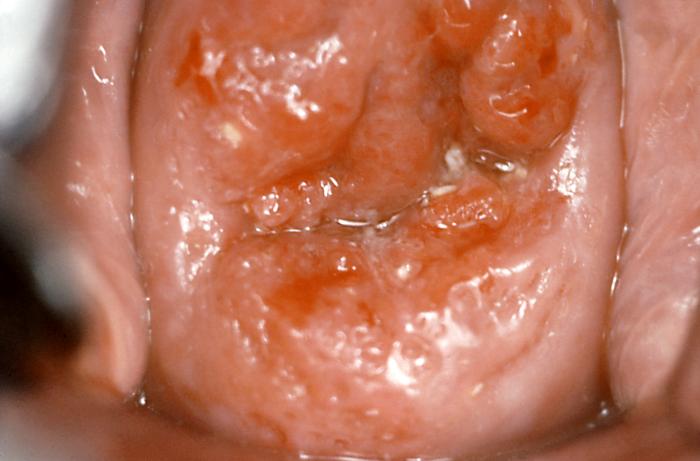[1]
Massad LS, Einstein MH, Huh WK, Katki HA, Kinney WK, Schiffman M, Solomon D, Wentzensen N, Lawson HW, 2012 ASCCP Consensus Guidelines Conference. 2012 updated consensus guidelines for the management of abnormal cervical cancer screening tests and cancer precursors. Journal of lower genital tract disease. 2013 Apr:17(5 Suppl 1):S1-S27. doi: 10.1097/LGT.0b013e318287d329. Epub
[PubMed PMID: 23519301]
Level 3 (low-level) evidence
[2]
de Sanjose S, Quint WG, Alemany L, Geraets DT, Klaustermeier JE, Lloveras B, Tous S, Felix A, Bravo LE, Shin HR, Vallejos CS, de Ruiz PA, Lima MA, Guimera N, Clavero O, Alejo M, Llombart-Bosch A, Cheng-Yang C, Tatti SA, Kasamatsu E, Iljazovic E, Odida M, Prado R, Seoud M, Grce M, Usubutun A, Jain A, Suarez GA, Lombardi LE, Banjo A, Menéndez C, Domingo EJ, Velasco J, Nessa A, Chichareon SC, Qiao YL, Lerma E, Garland SM, Sasagawa T, Ferrera A, Hammouda D, Mariani L, Pelayo A, Steiner I, Oliva E, Meijer CJ, Al-Jassar WF, Cruz E, Wright TC, Puras A, Llave CL, Tzardi M, Agorastos T, Garcia-Barriola V, Clavel C, Ordi J, Andújar M, Castellsagué X, Sánchez GI, Nowakowski AM, Bornstein J, Muñoz N, Bosch FX, Retrospective International Survey and HPV Time Trends Study Group. Human papillomavirus genotype attribution in invasive cervical cancer: a retrospective cross-sectional worldwide study. The Lancet. Oncology. 2010 Nov:11(11):1048-56. doi: 10.1016/S1470-2045(10)70230-8. Epub 2010 Oct 15
[PubMed PMID: 20952254]
Level 2 (mid-level) evidence
[3]
Wheeler CM, Hunt WC, Joste NE, Key CR, Quint WG, Castle PE. Human papillomavirus genotype distributions: implications for vaccination and cancer screening in the United States. Journal of the National Cancer Institute. 2009 Apr 1:101(7):475-87. doi: 10.1093/jnci/djn510. Epub 2009 Mar 24
[PubMed PMID: 19318628]
[4]
Bosch FX,de Sanjosé S, Chapter 1: Human papillomavirus and cervical cancer--burden and assessment of causality. Journal of the National Cancer Institute. Monographs. 2003
[PubMed PMID: 12807939]
[5]
Xi LF, Koutsky LA, Castle PE, Edelstein ZR, Meyers C, Ho J, Schiffman M. Relationship between cigarette smoking and human papilloma virus types 16 and 18 DNA load. Cancer epidemiology, biomarkers & prevention : a publication of the American Association for Cancer Research, cosponsored by the American Society of Preventive Oncology. 2009 Dec:18(12):3490-6. doi: 10.1158/1055-9965.EPI-09-0763. Epub
[PubMed PMID: 19959700]
[6]
Moscicki AB, Schiffman M, Kjaer S, Villa LL. Chapter 5: Updating the natural history of HPV and anogenital cancer. Vaccine. 2006 Aug 31:24 Suppl 3():S3/42-51
[PubMed PMID: 16950017]
[7]
Hildesheim A, Schiffman MH, Gravitt PE, Glass AG, Greer CE, Zhang T, Scott DR, Rush BB, Lawler P, Sherman ME. Persistence of type-specific human papillomavirus infection among cytologically normal women. The Journal of infectious diseases. 1994 Feb:169(2):235-40
[PubMed PMID: 8106758]
[8]
Wright TC Jr,Massad LS,Dunton CJ,Spitzer M,Wilkinson EJ,Solomon D, 2006 consensus guidelines for the management of women with abnormal cervical cancer screening tests. American journal of obstetrics and gynecology. 2007 Oct
[PubMed PMID: 17904957]
Level 3 (low-level) evidence
[9]
Paraskevaidis E, Koliopoulos G, Kalantaridou S, Pappa L, Navrozoglou I, Zikopoulos K, Lolis DE. Management and evolution of cervical intraepithelial neoplasia during pregnancy and postpartum. European journal of obstetrics, gynecology, and reproductive biology. 2002 Aug 5:104(1):67-9
[PubMed PMID: 12128266]
[10]
Boardman LA, Goldman DL, Cooper AS, Heber WW, Weitzen S. CIN in pregnancy: antepartum and postpartum cytology and histology. The Journal of reproductive medicine. 2005 Jan:50(1):13-8
[PubMed PMID: 15730167]
[11]
Moss JL, Reiter PL, Brewer NT. Correlates of human papillomavirus vaccine coverage: a state-level analysis. Sexually transmitted diseases. 2015 Feb:42(2):71-5. doi: 10.1097/OLQ.0000000000000225. Epub
[PubMed PMID: 25585064]

